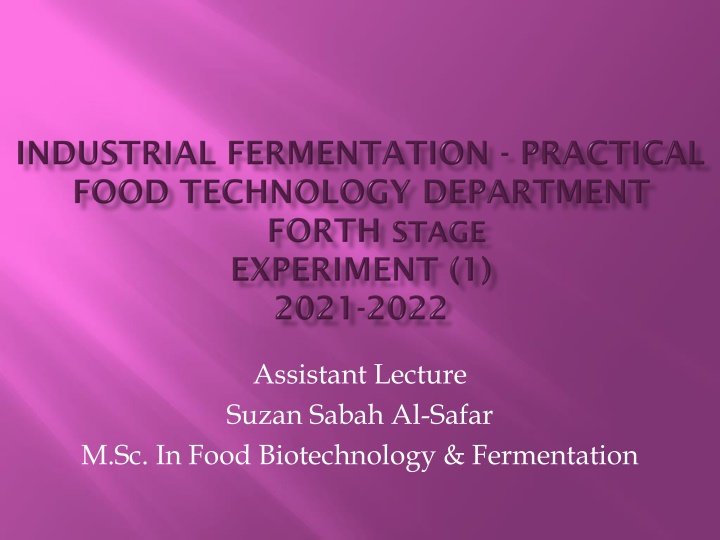
Fermentation in Food Biotechnology and Its Benefits
Explore the process of fermentation in food biotechnology, which involves the conversion of sugars to alcohol or organic acids using microorganisms under anaerobic conditions. Learn how fermentation leads to the development of aromas, textures, and flavors in food substrates, provides biological enrichment of food, and eliminates anti-nutrients. Discover the benefits of fermented foods, such as decreased cooking time, enhanced flavors, and the production of umami taste. Uncover the significance of lactic acid fermentation and the role of bacteria like Lactobacillaceae in this process.
Download Presentation

Please find below an Image/Link to download the presentation.
The content on the website is provided AS IS for your information and personal use only. It may not be sold, licensed, or shared on other websites without obtaining consent from the author. If you encounter any issues during the download, it is possible that the publisher has removed the file from their server.
You are allowed to download the files provided on this website for personal or commercial use, subject to the condition that they are used lawfully. All files are the property of their respective owners.
The content on the website is provided AS IS for your information and personal use only. It may not be sold, licensed, or shared on other websites without obtaining consent from the author.
E N D
Presentation Transcript
Assistant Lecture Suzan Sabah Al-Safar M.Sc. In Food Biotechnology & Fermentation
Is the alcohol or organic acids using microorganisms under anaerobic conditions. Fermentation usually implies that the action of microorganisms is desired. The term fermentation sometimes refers specifically to the chemical conversion of sugar alcoholic drinks such as wine, beer, and cider. However, similar processes take place in the leavening of bread (CO2 produced by yeast activity), and in the preservation of sour foods with the production of lactic acid, such as in sauerkraut and yogurt. process of converting carbohydrates to into ethanol, producing
It development of aromas, textures, and flavors in food substrates. Helps to preserve food with the help of alcohol, lactic acid, alkaline, and acetic acid fermentations. In addition, fermentation also adds biological enrichment of food with vitamins, protein, and amino acids. Another benefit of fermentation is the elimination of anti nutrients from food that can interfere with the absorption of nutrients in the body. is thought to enrich the diet with the 1. 2. 3.
Fermented foods also provide a decrease in fuel requirement and cooking time. Fermented foods have the benefit of changing flavors to become more fermented foods develop an umami flavor, such as fish and soy sauce. These help to bring a meatier flavor to dishes that do not have meat. 4. 5. complex. Some
1. Lactic acid fermentation: is the process of production of lactic acid by using of one molecule glucose and molecules of lactic acid under Anaerobic condition as it shown equation. convert it to two in the following
The lactic acid fermentation usually occurs by the Lactobacillaceae these bacteria reside in the foods naturally which called Flora for example, in sour foods such as sauerkraut. The most important bacteria which produce lactic acid and growth sequentially mesenteroids produce acid it is quantity 1%, and then Lactobacillus plantarum continue producing till (1.5-2)% and then continuous growth and production lactic acid till 2.5% . are Leconostoc Lactobacillus brevis
1. Homolactic lactic acid) is the simplest type of fermentation. The pyruvate from glycolysis undergoes a simple redox reaction, forming lactic acid. It is unique because it is one of the only respiration processes to not produce a gas as a byproduct. Overall, one molecule of glucose (or any six- carbon sugar) is converted to two molecules of lactic acid: fermentation; (producing only
It occurs in some kinds of bacteria (such as lactobacilli). that converts lactose into lactic acid in yogurt, giving it its sour taste. These lactic acid bacteria can carry out either homolactic fermentation, where the end-product is mostly lactic acid. In this type of bacteria 2. Heterolactic fermentation; where some lactate is further metabolized and results in ethanol and carbon dioxide, acetate, or other metabolic products.
2. Alcoholic fermentation: in this process one mole of glucose C6H12O6is converted into two moles of ethyle alcohol (ethanol) C2H5OH during conversion mono sacharide to pyrovic acid which converts to acid aldehyde and two moles of carbon dioxide, and then the acid aldehyde reduce to ethyle alcohol in anaerobic condition with the presence yeast as it shown in the following equation:
The yeast which use for fermentation is Saccharomyces cerevisiae and the specific species for production alcohol is ellipsoides. As mentioned yeasts perform this process in the absence of oxygen, alcoholic fermentation is classified as anaerobic. 3. Acetic acid fermentation: in this process one mole of ethanol will oxidized to the acetic acid and water with the presence of acetic acid bacteria (Acetobacter aceti) as it shown in the following equation:



















